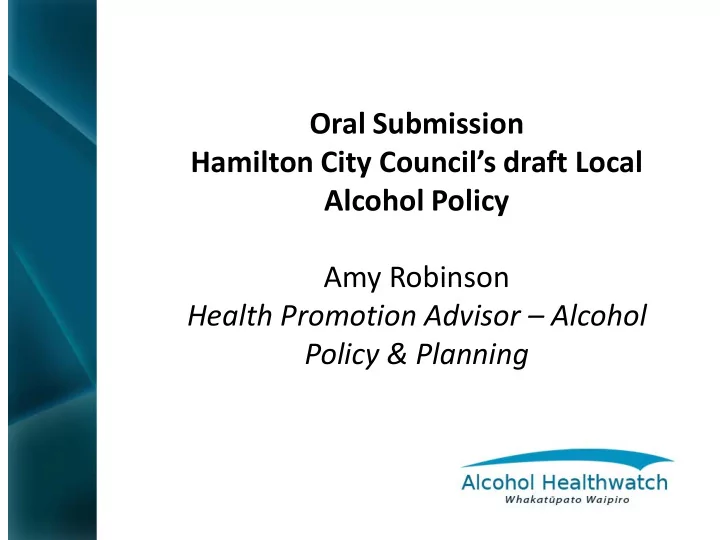

Oral Submission Hamilton City Council’s draft Local Alcohol Policy Amy Robinson Health Promotion Advisor – Alcohol Policy & Planning
Why are we here?
• The Object of the SSAA 2012 • (a) the sale, supply, and consumption of alcohol should be undertaken safely and responsibly; and • (b) the harm caused by the excessive or inappropriate consumption of alcohol should be minimised. • The intent of the LAP legislation To reduce the accessibility & availability of alcohol
Reducing alcohol-related harm – what does the evidence say • Reducing the accessibility and availability of alcohol – one of 3 best policy buys • Reducing the trading hours of licensed premises and reducing the number of alcohol outlets are your two big ticket items
Strategy or intervention Effectiveness Breadth of Cross- Cost to research cultural implement support testing and sustain Regulating physical availability Total ban on sales +++ +++ ++ High Minimum legal purchase age +++ +++ ++ Low Rationing ++ ++ ++ High Government monopoly of retail sales +++ +++ ++ Low Hours and days of sale restrictions ++ ++ ++ Low Restrictions on density of outlets ++ +++ ++ Low Server liability +++ + + Low Different availability by alcohol strength ++ ++ + Low Taxing and Pricing Alcohol Taxes +++ +++ +++ Low Altering the drinking context Outlet Policy to not serve intoxicated patrons + +++ ++ Moderate Training bar staff and managers to prevent and + + + Moderate better manage aggression Voluntary codes of bar practice 0 + + Low Enforcement of on-premise regulations and ++ + ++ High legal requirements Promoting alcohol-free activities and events 0 ++ + High Community mobilization ++ ++ + High
Strategy or intervention Effectiveness Breadth of Cross- Cost to research cultural implement support testing and sustain Education and persuasion Alcohol education in schools 0 +++ ++ High College student education 0 + + High Public services messages 0 +++ ++ Moderate Warning labels 0 + + Low Regulating alcohol promotion Advertising bans + ++ ++ Low Advertising content controls ? 0 0 Moderate Drinking-driving countermeasures Sobriety check points ++ +++ +++ Moderate Random breath testing (RBT) +++ ++ + Moderate Lowered BAC Limits +++ +++ ++ Low Administrative licence suspension ++ ++ ++ Moderate Low BAC for young drivers (‘zero tolerance’) +++ ++ + Low Graduated licensing for novice drivers ++ ++ ++ Low Designated drivers and ride services 0 + + Moderate Treatment and early intervention Brief intervention with at-risk drinkers ++ +++ +++ Moderate Alcohol problems treatment + +++ +++ High Mutual help/self-help attendance + + ++ Low Mandatory treatment of repeat + ++ + Moderate drinking-drivers
Trading Hours - Recommendations • On-licences • CBD area: 10am – 2am • Suburban/Rural: 10am – 12am One way door –If implemented, should be mandatory and 2 hours in duration • Off-licences • 10am – 9pm (no exclusions).
Trading Hours - Evidence • Restricting trading hours is the most effective and cost-effective measure available to reduce alcohol-related harm associated with licensed venues
Trading Hours - Evidence • 37% decrease in assaults in Newcastle, Australia & decrease in pre-loading • 64% decrease in recorded violent incidents in Timaru • New study - IAC study (2014) – Drinkers purchasing alcohol after 2am from on- licences – 2.9 times more likely to drink larger amounts • Drinkers purchasing alcohol after 10pm from off-licences more likely to be larger consumers
Numbers of alcohol outlets - Recommendation • Controls aimed at decreasing the number of alcohol outlets should be implemented across NZ • May include a regional cap and/or a sinking lid in high stress/risk areas on all licence types of one particular type
Numbers of alcohol outlets - Evidence • Outlet density is associated with alcohol related problems including violence, anti-social behaviour, injuries, crime and binge drinking.
Location - Recommendation • Location based controls be strengthened in the Local Alcohol Policy to protect children, young people and other vulnerable groups • Pleased to see controls included to help with this.
Other Matters • Discretionary Conditions • Relying on good order and amenity • COVEC report • Economic benefits/vibrancy
Conclusion • Local Alcohol Policies were designed to enable community input into local liquor licensing decisions • Listen to your statutory agencies • Reducing trading hours and the number of alcohol outlets in your community will make a difference • You can’t expect change by practicing the same behaviours!
Recommend
More recommend